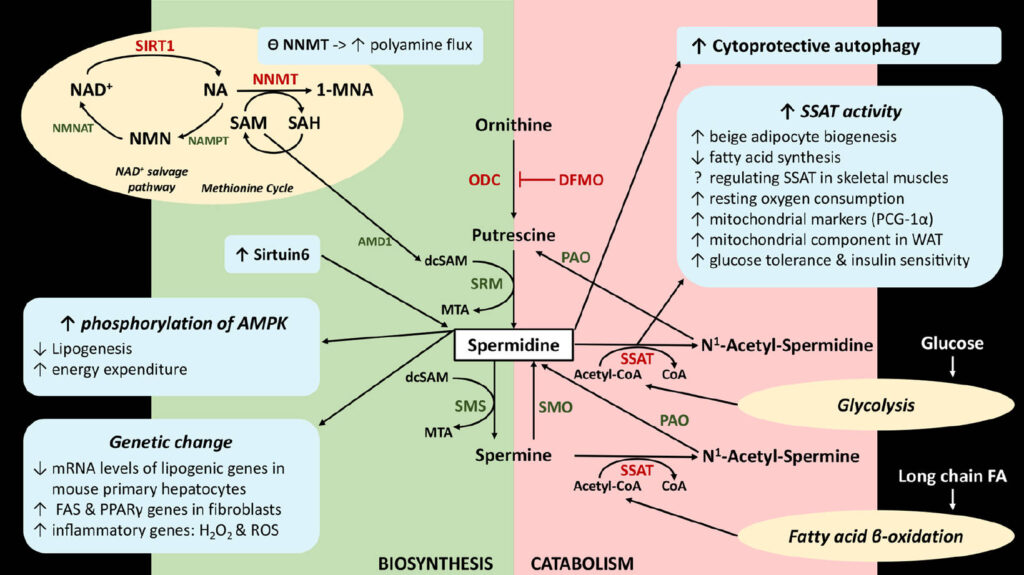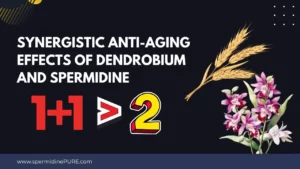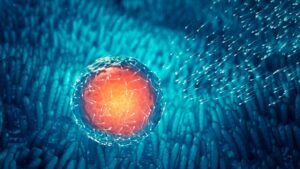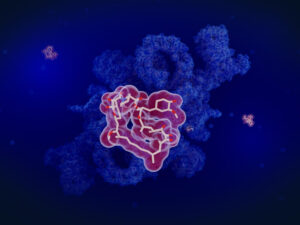Spermidine is a polyamine naturally found in all living cells, including human cells. It is a positively charged molecule that plays an important role in various biological processes, including cell growth, differentiation, and apoptosis. Research has shown that spermidine has anti-aging properties and can help to promote cellular health and longevity. Another interesting finding was the relationship between spermidine and obesity. Moreover, animal models have demonstrated that spermidine supplementation protects against diet-induced obesity. However, spermidine levels were increased in obese kids and metabolic syndrome patients with type 2 diabetes. This study focuses on the spermidine effects in vitro and in vivo in obese people.
How spermidine affects our body?
The spermidine synthase, present in all live cells, converts the polyamine putrescine into spermidine. According to in vivo research, spermidine/spermine N-1-acetyl-transferase (SSAT), the rate-limiting enzyme in polyamine catabolism, can be activated to enhance lipid and glucose metabolism.
Spermidine is naturally found in almost all plant-based food, including wheat germ, soybeans, mushrooms, legumes, and more.
The ability of spermidine to trigger the cellular process known as autophagy is one of the main ways to affect metabolism. Through autophagy, cells naturally break down and recycle damaged or defective parts, such as organelles and proteins. Spermidine has been demonstrated to boost this process’s effectiveness, enhancing metabolic function and lowering the risk of metabolic diseases. Also, it has been shown that spermidine enhances mitochondrial function, which is crucial for energy metabolism. The “powerhouses” of the cell, mitochondria, generate energy in the form of ATP. Spermidine enhances mitochondrial respiration, the process by which mitochondria create ATP, and mitochondrial biogenesis, where new mitochondria are formed.
When consumed through the diet, polyamines are absorbed in the gastrointestinal tract, primarily in the small intestine. It is worth noting that the absorption and metabolism of polyamines are complex and may be influenced by various factors, including diet, gut microbiota, and disease conditions. For example, certain foods, such as fermented foods, are rich in polyamines and may increase their absorption in the gut. On the other hand, gut inflammation and other gut disorders may affect the absorption and metabolism of polyamines, potentially leading to imbalances in their levels. Spermidine has also been shown to activate the sirtuin family of proteins, which are involved in regulating cellular metabolism and have been linked to longevity.

Several mechanisms have been identified through which spermidine can alter biochemical components and gene expression in various cell types. These mechanisms include modifications to genetic expression, enhancements to glucose and lipid metabolism, improvements to energy metabolism, and increased cytoprotective autophagy. Additionally, biosynthesis (green), catabolism (pink), other associated pathways (yellow), and a proposed mechanism for the beneficial effects of spermidine (blue) have been identified.
The key findings
In both the physiological (non-obese) condition and diet-induced obese models, increased spermidine and polyamine catabolism positively impact metabolic pathways, according to a study on spermidine and obesity. These beneficial effects work through a number of methods, such as altered gene expression, enhanced glucose and lipid metabolism, improved energy metabolism, and increased autophagy. Spermidine is a chemical that protects against obesity and cardiovascular illnesses, according to evidence from epidemiologic and clinical trials. Based on this, spermidine-rich food and supplements may be helpful for those who suffer from obesity and cardiovascular disease.
In vivo spermidine studies
Several in vivo studies have investigated the effect of exogenous spermidine supplementation on metabolic profiles in obesity, and the results are promising. Giving intraperitoneal injection of spermidine in diet-induced obesity mice once daily for four weeks protected NASH by reducing the expression of lipogenic genes via activating the AMPK pathways.
Another study investigated the effects of spermidine supplementation on glucose metabolism in obese mice with type 2 diabetes. The study found that spermidine supplementation improved glucose tolerance and insulin sensitivity in these mice, and also led to a reduction in body weight and adiposity.
Spermidine administration combined with physical activity has been shown to significantly improve certain parameters in sucrose-induced obese mice compared to spermidine alone. There is emerging evidence suggesting that spermidine supplementation may have beneficial effects on exercise performance and recovery. Some studies have found that spermidine supplementation can increase muscle mass and strength, improve endurance and exercise capacity, and reduce muscle damage and inflammation following exercise.
Spermidine supplementation has been shown to significantly reduce weight in diet-induced obese mice and improve insulin resistance by lowering metabolic endotoxemia and enhancing intestinal barrier function. Most studies examining the effects of exogenous spermidine supplementation showed that it positively impacted many processes, such as energy metabolism, glucose metabolism, and lipid metabolism. More research is required to understand the processes underlying these effects and establish the ideal dosage and duration of spermidine supplementation for metabolic positive benefits.
Limitations in the study
Several epidemiological and clinical studies have investigated the alterations of polyamines in obese subjects with mixed results. Although spermidine supplementation shows positive health results, there are still some limitations.
One limitation is that the report from an epidemiological study does not directly represent true individual outcomes, individual exposure, and confusing characteristics. In addition, there was a lack of data regarding important factors, such as time of exposure to polyamine-rich food, exact dose per body weight, and individual serum polyamine levels. Moreover, in vivo studies with precise polyamine dosages and durations in both regular and diet-induced obesity models are required to assess the results of polyamines on cardiovascular outcomes. Another possible explanation for these inconsistent findings is a difference in the samples of each study. Finally, evidence regarding the effects of polyamine and obesity in human subjects is still short.
To sum up
Spermidine is a molecule that protects against obesity and cardiovascular diseases, according to many findings. Spermidine-rich diets and supplements may be helpful for those who suffer from these conditions. While evidence from in vitro and in vivo studies suggests that polyamines, particularly spermidine, may have beneficial effects on metabolic pathways and cytoprotective autophagy, investigations regarding the effects of polyamine and obesity in human subjects are still insufficient. More research is needed to fully understand the potential benefits of polyamines in obesity and metabolic diseases.
Literature
Choksomngam Y, Pattanakuhar S, Chattipakorn N, Chattipakorn SC. The metabolic role of spermidine in obesity: Evidence from cells to community. Obes Res Clin Pract. 2021 Jul-Aug;15(4):315-326. doi: 10.1016/j.orcp.2021.06.009IF: 5.214 Q2 . Epub 2021 Jul 1. PMID: 34217652.



